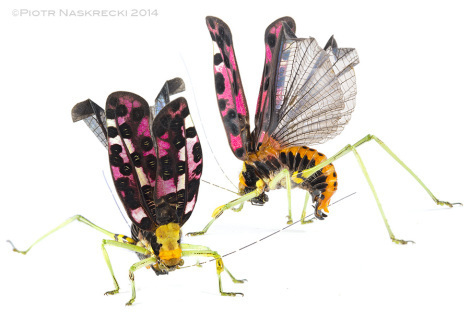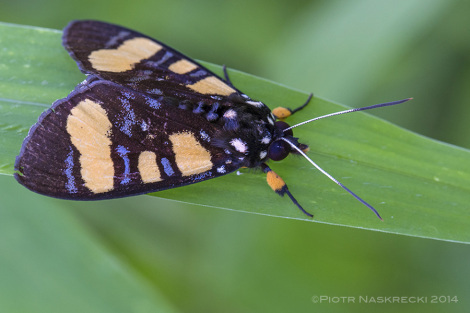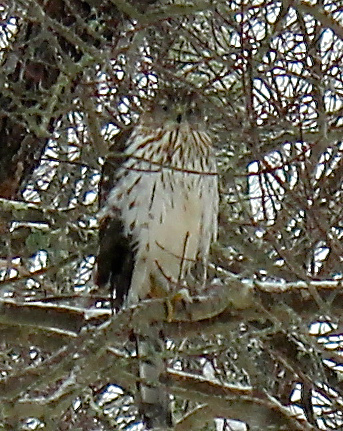Richard Conniff's Blog, page 52
February 19, 2014
New Species of Marathon Sex Specialist Discovered
This is a comedy, or a tragedy, about what it really means to go out with a bang. And you say natural history is dull sort of stuff? This account comes from Elise Worthington at ABC News, Australia’s Public Broadcasting outlet:
Queensland scientists have discovered a new species of mouse-like marsupial renowned for its deadly breeding habits in the Gold Coast hinterland.
The carnivorous antechinus received international attention last year after scientists found the male of the species was dying from stress after over-enthusiastic marathon mating sessions.
Now researchers have discovered a new species, the black-tailed antechinus.
It is thought the species is only found in high-altitude, wet areas in the Springbrook National Park between northern New South Wales and the Gold Coast Hinterland.
Dr Andrew Baker, from the Queensland University of Technology, says researchers are applying for an endangered species listing while they conduct more research.
“They probably follow the typical pattern of antechinus, which is all males are dead before they turn one year old,” he said.
He says usually antechinus have a “frenzied mating period” when they are about 11 months old, and “all males will die before the young are born”.
Dr Baker says it is not yet known how many of the species exist, but he describes them as “quite striking”.
“The tail emerges from a body that is very shaggy, very hairy, with really long guard hairs,” he said.
“On the rump of the animal it becomes almost an orangey-brown colour, but where the tail emerges from the rump there is quite a distinct change from orange rump to black tail.
“It’s a very short-furred tail and they have black feet as well.”
The new findings are published in the scientific journal Zootaxa.
Last year, biologist Diana Fisher from the University of Queensland spoke about the animal’s mating habits.
Dr Fisher was the lead author of a study published last year in the journal Proceedings of the National Academy of Sciences, which explained why the die-off happens.
Antechinus go out with a bang
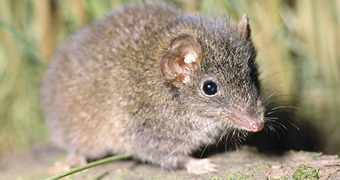
Australia’s little marsupial mice live fast and die young in a frenzy of winter mating known as big bang reproduction.
Previously scientists thought the bizarre pattern was due to the males being altruistic and leaving more food for their offspring.
But Dr Fisher’s study showed the animals were actually over-doing it in order to promote their own genes over their competitors’ genes, and trying so hard to reproduce that their bodies shut down.
“What they do is just competitively mate, so they mate for a very long time, like 12 to 14 hours, some of the species,” she said.
“They do it over and over and over – they’re very promiscuous. There’s this huge intense mating season going on for about two weeks.”
Dr Fisher says the males experience an escalation of stress hormones, which allows them to continue mating for a long time.
But the researchers found the extreme rush of stress hormones also caused the animals’ body tissues to “disintegrate”.
“It’s a bit distressing to see them die,” she said.
“Their fur falls off. They look very sick and stagger around, and sometimes they get gangrene infections because their immune system stops working.”


A Field Biologist’s Vision of Heaven and Hell
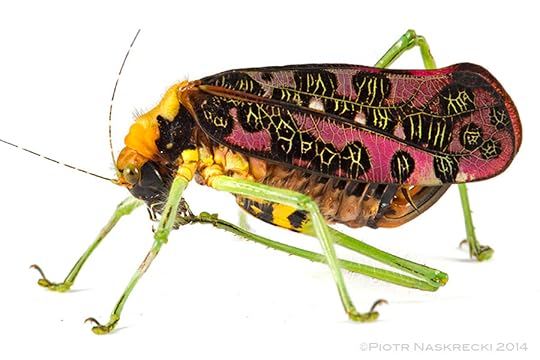
A female P. reimeri cleaning her foot. (Photo: Piotr Naskrecki)
The great field biologist Piotr Naskrecki has posted this item on his TheSmallerMajority blog:
Ever since I can remember I have been having a recurring nightmare: I am in some incredible location – usually somewhere in the tropics, there are amazing insects everywhere, often those that I have been dying to find, but I need to leave immediately and have none of my collecting gear – not a single vial, no net, no camera (not everybody can relate, I realize, but entomologists know what I am talking about). And last month I finally got to live through this bad dream.
A defensive display of Pardalota reimeri – these katydids feed on highly toxic plants and is likely that their bodies are loaded with poisonous alkaloids.
Before coming to Gorongosa I flew to the northern town of Pemba where a newly opened campus of the University of Lurió trains Mozambican students in biology and engineering. It was supposed to be a strictly-business trip, meeting lecturers and students, and for this reason I did not bring with me any collecting or sound recording equipment, and only the most basic photo gear. But my friend Harith had a better idea and decided to take me on a short trip to Quirimbas National Park, famous chiefly for its spectacular marine life. Some of his students were working on insect and amphibian faunas of the park, and I said, “Why the hell not.” The seemingly easy trip turned briefly into hell after our Mitsubishi truck decided to part ways with its clutch right in the middle of nowhere. After a long while a friendly driver in a passing car went to fetch a tow truck for us, and eventually we made it to the park.
An unidentified, aposemtically-colored tiger moth found on the same plants as Pardalota.
The first thing that I noticed was the wall of insect sound. The lush miombo forest reverberated with loud katydid calls, ones that I did not recognize. They were unusual for a couple of reasons. One, it was the middle of a hot, African day, and katydids tend not to like it, preferring to call under the cover of the night. And two, the calls were continuous, low frequency, and very complex. They were telling everybody with ears, “Here I am, come and get me.” And when you do that you better have a good trick up your sleeve to protect yourself, as katydid ladies are not the only ones listening: birds, lizards, monkeys, they all love big, juicy insects.
The katydids were calling from high in the trees and I was afraid that I would not be able to catch, or even see them. But then one flew down from the canopy and landed right in front of me. When I saw what it was, my heart skipped a beat – it was Pardalota reimeri, the Holy Grail for katydid aficionados (there are a few of us out there). This species had been known only from the original type series, described in 1911 and preserved in a museum in Berlin. What is special about this species is that even those old, dried husks retained vivid, crazy colors, unlike those of any other known katydid species. And colors as awesome as this indicate an equally awesome biology.
I caught the katydid and he immediately went into a defensive mode: he opened his bright purple, black and white wings, and exposed his neon-orange abdomen and cervical membrane; he lifted his hind legs that had yellow and black markings, remarkably similar to those of toxic chrysomelid beetles. This was either a daring bluff, or this thing was seriously poisonous.
Read the rest of Naskrecki’s account here.


February 18, 2014
Are Elephants As Smart and Social As We Like To Think?

(Photo: Elise Gilchrist/ Think Elephants International, Inc.)
My latest for Takepart, the web site of the movie company Participant Pictures:
One time, in Botswana’s Okavango Delta, I was visiting with researchers studying a baboon troop when one of the animals became separated from her mates. In the distance, Sashe, as we knew her, started to give out her tremulous, plaintive “lost call,” repeating it over and over. It was so heartrending that, after more than a half hour, all of us wanted to go out and lead her back by the hand ourselves. But the really disturbing thing was to be with the troop, and see her friends and family going about their business, blandly indifferent, as if deaf, to Sashe’s plight.
Monkeys may look like us. They may even act like us in some circumstances. But they don’t have our capacity for empathy. They cannot put themselves in another animal’s place. So far, researchers have been able to demonstrate that ability to identify with and console a distressed individual only in great apes, some canines, and a few corvids, such as rooks and ravens.
It’s different, though, for elephants—or at least that’s what we’ve always believed. A new study published in the journal PeerJ and conducted in Thailand systematically tests that belief for the first time. “The reaction to this from the public,” says lead author Joshua Plotnik, who did the research as a doctoral student at Emory University, “is probably going to be ‘Why are scientists doing this? We already knew that.’ Which is of course one of the biggest problems in science. People assume something is true because they heard about it, or they saw a video, without ever testing it empirically.” But if we just accepted what we think we see and never tested it, says coauthor Frans de Waal (one of the world’s foremost experts on animal behavior), we’d still believe the world is flat.
The idea for the new study was to put to the test all the sentimental assumptions we make when we see the videos of elephants seeming to comfort one another, or band together to help a fallen individual, or even seemingly grieve for their dead. Plotnik did his research at a 55-acre tourism facility, the Elephant Nature Park, in Thailand’s Chiang Mai Province. The elephants there tend to be rescued animals, organized in artificial groups, and closely managed by their mahouts. The fenced areas where they live often also include rescued dogs.
It’s about as far from a natural population as you can get. But observing detailed social interactions would have been impossible in the dense forests where wild Asian elephants still live. The study also followed the practice that de Waal has made standard at Emory University’s Yerkes National Primate Research Center: Start by closely observing and recording how animals in captive groups behave; then test the findings, where possible, in the wild.
Everyday circumstances at Elephant Nature Park—a dog being a nuisance or another elephant becoming aggressive—gave the elephants plenty of occasion to trumpet their distress, with ears flared out, tail raised, and trunk stiffened. Plotnik’s job was to record what happened over the next 10 minutes. Consistently, the other elephants responded, by trumpeting and bouncing their trunks in agitation or, if they were close to the victim, making a bird-like chirping sound.
That could just be emotional contagion, as also happens in humans: “He’s upset; I’m upset; everybody’s upset; I don’t know why we’re upset.” But other animals also often moved toward the distressed individual and made reassuring vocalizations and physical contact, touching the animal around the genitals and face. They sometimes bunched up protectively around the troubled individual.
Two older females were especially close. Jokia was apparently blind and easily alarmed. At the sound of her roaring, trumpeting, or rumbling, her friend Mae Pern typically moved quickly to her side. Each of them would put her trunk in the other’s mouth, says Plotnik, much as chimps put a finger in another chimp’s mouth, as a form of reassurance. “It’s as if to say, ‘I’m in a very vulnerable position. I’m not a threat to you. I’m here to help you.’ ” (But consolation only goes so far. At times, Mae Pern also seemed to take advantage of Jokia’s blindness to filch her food.)
The findings from the new study are in some ways reassuring for humans too: We take comfort in the idea that elephants have a special intelligence and a social sense akin to our own. And increasingly scientific evidence seems to confirm that this is the case. (In a previous experiment at Elephant Nature Park, for instance, Plotnik and his coauthors found that elephants quickly mastered a task requiring two of them to partner up and pull simultaneously on either end of a rope to bring food within reach.)
But Plotnik, now a postdoctoral fellow at Cambridge University and founder of the nonprofit Think Elephants International, says he also hopes to apply his findings in elephant conservation. In Thailand, as elsewhere in Asia and Africa, hungry elephants often raid crops and attack farmers, and the farmers generally want them gone. But if we understand how elephants perceive the world, particularly by sound and smell, says Plotnik, “we can say, ‘Let’s try to think like an elephant.’ If we can understand how they use their sense of smell to navigate their physical world,” it becomes possible to design smarter conservation protocols using olfactory or other cues. He points to work by Lucy King of Save the Elephants. Because elephants dislike bees, she’s developed a project to construct inexpensive “beehive fences,” not only protecting farmland from elephants but also providing farmers with additional income from honey.
Understanding how elephants really think is thus not just a means of confirming our sentimental notions. It’s also how we can ensure that intelligent (and not so intelligent) fellow creatures continue to have a place to live in this world.


The Young and the Wild on the Streets of LA

Gopher snake schools juvenile red-tailed hawk on the streets of the city
I’ve written a few posts lately about wildlife in the city. Then, last night on Facebook, I happened to run across this strange photo, taken on December 28 in the middle of Los Angeles, not far from Dodger Stadium.
The photographer was “David A.” and this account seems to come from a friend: “It’s hard to say what a hawk was doing tangled up with a snake in the middle of Scott Avenue in Echo Park on Friday afternoon. But David A., who snapped the photo above, and a few other people watched and waited as the serpent and bird of prey were locked in a strange embrace on the pavement near Elysian Park: ‘I thought I heard one person say that they thought the hawk had been run over as it just came down with the snake in the street. It must have just grabbed it. I was there maybe five minutes. In that time, the hawk was in the position pictured and the snake was slowly freeing itself (not so much wrestling). The hawk wasn’t moving much. We stood by to make sure no cars would run them over. Once free, the hawk flew off and seemed to not be harmed. The drama ended with the snake slowly slithering back in the direction of the park,’ David said.”
One Facebook commenter suggested that, in the manner of Hollywood stars drawing unwanted attention, the hawk is saying, “No pictures, please.”
Here’s a more informed explanation by Greg Pauly of the Los Angeles County Natural History Museum.
The posting also brought out this even more spectacular photo of a similar event in Costa Rica:

(Photo: © Federico Oviedo-Brenes)
Here’s a description of what happened: “This started out as a predation attempt by a Buteo magnirostris (Roadside Hawk) on a Mastigodryas melanolomus (Salmon-bellied Racer) in Costa Rica. But the tables were turned as the snake managed to tie up the hawk to the point of exhaustion. Photo © Federico Oviedo-Brenes et al. (2013. Herpetological Review 44[4]:693).”
UPDATE: Having posted this earlier this morning, I now find myself trying to work while watching a hawk that appears to have corner a songbird in a rosebush just outside my office. With apologies for the very poor photo:


Goodall: Colonialist China in New Scramble for Africa

(Photo: Michael Collopy)
This comes from Agence France-Presse in Johannesburg, via today’s South China Morning Post:
China is exploiting Africa’s resources just like European colonisers did, with disastrous effects for the environment, acclaimed primatologist Jane Goodall has said.
On the eve of her 80th birthday, the fiery British wildlife crusader is whizzing across the world giving a series of lectures on the threats to our planet.
And the rising world power’s involvement on the continent especially raises alarms when it comes to her beloved chimpanzees and wildlife habitats.
During the last decade China has been investing heavily in African natural resources, developing mines, oil wells and running related construction companies.
Activists accuse Chinese firms of paying little attention to the environmental impact of their race for resources.
“In Africa, China is merely doing what the colonialist did. They want raw materials for their economic growth, just as the colonialists were going into Africa and taking the natural resources, leaving people poorer,” she said in an interview in Johannesburg.
The stakes for the environment may even be larger this time round, she warns.
“China is bigger, and the technology has improved… It is a disaster.”
In Africa, China is merely doing what the colonialist did
Jane GoodallOther than massive investment in Africa’s mines, China is also a big market for elephant tusks and rhino horn, which has driven poaching of these animals to alarming heights.
But Goodall, who rose to fame through her ground-breaking research on chimpanzees in Tanzania, is optimistic.
“I do believe China is changing,” she said, citing as one example Beijing’s recent destruction of illegal ivory stockpiles.
“I think 10 years ago, even with international pressure, we would never have had an ivory crush. But they have,” she added.
“I think 10 years ago the government would never have banned shark fin soup on official occasions. But they have.”
‘Small window of time’
Her organisation Roots and Shoots, founded over two decades ago to instil conservation values in children, has also become involved in China.
“We work with hundreds of Chinese children, and they are not different from children we work with here. They all love nature, they love animals, they want to help, there’s no difference because they’re Chinese,” she said.
Young people’s enthusiasm to change the world is a major reason to hope, for this lady with seemingly inexhaustible energy who can still keep an auditorium hanging on her words for more than an hour.
“These young people will become the next parents, the next teachers, the next lawyers, the next business people and the next politicians, some of them.”
“The biggest problem is that people understand but don’t know what to do,” she said.
“If you have one thousand, one million or eventually several million people all making the right choice, all thinking about the consequence of their behaviour, then we’re going to see big change.”
Another glimmer of hope is “this amazing resilience of nature,” she continued, citing as an example the China’s Loess Plateau on the Yellow River bouncing back after massive soil erosion.
“It was set to be the biggest totally destroyed ecosystem in the world,” she said.
A US$400-million project funded by the Chinese government and international donors introduced better farming methods in the area, which greatly reduced erosion and lifted 2.5 million people out of poverty, according to the World Bank.
“That took a lot of money, but if you look at it now, it’s all green, lush and farmland, and children have come back from the cities. It’s even got a whole area for wildlife,” said Goodall.
“We still have a small window of time to change things.”


February 17, 2014
Yes, Hotshot Harry Can Be A Hunter and a Conservationist, Too
Britain’s Prince Harry continues to take heavy flak for being simultaneously a hunter and a conservationist, with the appearance in today’s Daily Mail of the above photograph. It’s 10 years old, and shows “Crackshot Harry, The Buffalo Killer” in Argentina, smiling over the carcass of a water buffalo, not exactly an endangered species.
Harry has been taking a public relations hit since going out earlier this month on a boar hunt in Spain with his brother William, immediately prior to making a public pledge to fight against the illegal trade in ivory, rhino horn, tiger parts and other endangered animals.
My Irish and American family background means I am no great fan of royalty, and I should probably welcome the endlessly clumsy, tone-deaf behavior by the British Royals. It makes a better case for republicanism than any Fenian or Federalist ever did. (And it’s so much more entertaining.) But that said, a legal hunt for water buffalo or boar is no threat to species or populations. It bolsters support for wildlife by bringing money into rural communities. That’s the exact opposite of driving species to extinction and stealing community resources by poaching ivory, rhino horn, tiger parts, and so on.
Harry is right to take a stand against the ivory and rhino horn trades. Attacking him for being a hunter just takes the focus off the genuine threat from illegal wildlife trafficking. It’s a way for us to indulge a warm sense of righteous outrage without actually doing anything whatsoever to help wildlife.


Kareiva Responds on Human Needs and The Tide of Extinctions
The Nature Conservancy’s Peter Kareiva has sent a helpful response to my recent article “Is Focusing On Human Needs Like Saying ‘Yes’ To Extinctions” I’m putting it up as a separate post because it deserves more attention than it might get as a comment to the previous article. First, here’s what I wrote as an afterthought to the original article:
Kareiva, when I spoke with him, seemed to be much more adept at blowing up conventional conservationist thinking than at pointing out new ways forward. (He was vague about the details on that.) Cafaro, on the other hand, seemed stuck in 1960s outrage, in ways that also don’t advance the way society treats conservation issues. Here’s what I woke up this morning thinking: Instead of wasting their energy in bitter and divisive squabbling, maybe they should be collaborating to play good cop-bad cop with the culprits who are actually causing environmental destruction?
Here’s Kareiva’s response:
Richard is correct that when he called me I was vague about ideas—I was between sessions at the AMS meetings in Atlanta, trying to find a room for a talk, and distracted. But we have lots of specific ideas.
First check out the Natural Capital Project which has over twenty specific projects around the world (http://www.naturalcapitalproject.org/). “NatCap” mainstreams conservation by making the benefits people derive from nature explicit and transparent.
Second, our efforts to broaden the conservation tent include LEAF (see http://www.nature.org/about-us/careers/leaf/).
And yes, I wish we had better documentation of what works and does not work. In general conservation has not been terrific at really testing the effectiveness of its different efforts — but the field has learned and is learning, and most conservation NGO’s are making a serious effort to monitor their impact (http://www.conservationmeasures.org/). But these are new ideas. For that reason we have also launched a science effort that aims to work at the convergence of ecology, conservation, economics and action to examine these new ideas. A good example of this is a study of how natural defenses can help provide coastal resilience (see http://www.snap.is/groups/coastal-defenses/).
Richard is also right in suggesting that this bickering and in-fighting is a waste of energy and time. Professor Marvier and I never meant to demean or discredit any of our conservation colleagues. We have the utmost respect for Michael Soule, and in fact wrote about his paper out of respect –if we did not respect it, we would not have paid any attention to it. I suggest folks read our Bioscience paper and ask themselves if we were disrespectful. We think there is room for all possible strategies and values in service of conservation –from radical to compromising, from utilitarian to intrinsic value, from pragmatic to purist. It is only with a broad based coalition that we will be able to address the big challenges facing conservation – climate change, land conversion, and degradation of freshwater and marine systems. There is not one and only one “true conservation” –there are many faces and reasons for conservation. We should muster them all in a joint effort.
As Professor Marvier writes,
“At the end of the day, all conservationists — both “new” and “traditional” — very much want to stem the tide of extinction. We all want abundant, beautiful natural spaces. We all agree that the relatively pristine places on our planet are a top priority for protection and that protected areas will continue to be an important part of conservation” (see http://www.snap.is/magazine/new-conservation-friend-or-foe/ for full essay)
Peter Kareiva


February 16, 2014
Hearing Chainsaws in the Forest? Could Just Be A Lyre Bird.
This brief video may not look like much at first, just David Attenborough creeping through another forest in pursuit of another curious creature. This time, though, it’s Australia superb lyre bird, which he touts as having what may be “the most elaborate, the most complicated, the most beautiful song” in the world.
It doesn’t even sound like much at first.
But hang on.
And, oh, sorry to say, but if you are anywhere other than southeastern Australia, that sound you’re hearing is in fact a chainsaw.


February 15, 2014
Is Focusing on Human Needs Like Saying “Yes’ to Extinctions?
My latest for Takepart (the web site of the movie company Participant Pictures):
When modern conservationists seem to put human welfare ahead of the needs of wildlife, are they betraying the movement’s central tenets? That’s the argument made by the authors of a new editorial in the journal Biological Conservation. In fact, it’s less an argument and more like an angry accusation, relying heavily on the phrase “great moral wrong.”
The editorial taps into a growing uneasiness among some conservation biologists about the direction of the conservation movement as it struggles to find the most effective role in an era, the so-called Anthropocene, in which human expansion seems to be having a devastating effect on almost every species and landscape on the planet—via habitat destruction, poaching, bush-meat hunting, pollution, and climate change.
Prominent environmental groups—among them The Nature Conservancy and Conservation International—have responded to this change with an increasing emphasis on how deeply human survival depends on the things nature provides: “ecosystem services” like clean water, crop pollination, flood control, putting oxygen into the atmosphere and pulling carbon dioxide out, wildlife habitat, and recreation.
This shift in emphasis means that environmental groups now often work side by side with old adversaries, from indigenous communities crowding around conservation areas to Fortune 500 companies looking to clear-cut, mine, harvest, or otherwise exploit the landscape. The shift to a more human-oriented approach has sometimes resulted, notably at Conservation International, in an exodus of species-oriented biologists.
What gets lost in the process, according to the editorial, is the defining environmental belief that any extinction caused by humans is “a great moral wrong.” The coauthors are Richard Primack, a biologist at Boston University, and Philip Cafaro, a philosophy professor at Colorado State University, and they are also, respectively, editor and book review editor of Biological Conservation.
They direct much of their attack at Peter Kareiva, the iconoclastic chief scientist for The Nature Conservancy, and Michelle Marvier, a conservation biologist at Santa Clara University and coauthor of the textbook Conservation Science: Balancing the Needs of People and Nature.
Kareiva and Marvier’s recent attempts to redefine conservation have put so much emphasis on increasing human wealth via “economic development” and “working with corporations,” according to Primack and Cafaro, that they completely neglect “the right of other species to continue to flourish.” Kareiva and Marvier use rhetoric, they say, that contemplates “mass extinction with equanimity, in part, apparently, because such extinctions will not necessarily inconvenience human beings.”
When I asked Kareiva about the attack, he pointed out that the articles Primack and Cafaro mention were chiefly directed at other biologists, for whom a statement of opposition to mass extinctions would have seemed superfluous, at best. “The point was to say, ‘Hey, biologists, learn some economics; learn social science. It’s relevant.’ ” He added that he entered the conservation movement as a species biologist “totally from the ‘let’s sue ’em; let’s stop logging” side of things. But experience fighting for spotted owls and salmon had made him think the approach produced more political fireworks than results and often shut out people who might otherwise participate in conservation.
Global companies that “care about social license to operate” and about public and shareholder opinion can be “pretty cooperative,” he said, especially if you point them to choices that allow them to protect habitat while also getting the resources they covet. “They become conservation allies,” he said. But he added, “No successes yet, lots of collaboration, and we’ll see how it turns out.”
Kareiva also argued for an increasing focus on letting local communities share in the management of conservation areas, as a way of providing them with both the means to survive and incentives to work for wildlife preservation. In a formal reply to be published in Biological Conservation, Kareiva and Marvier argue that taking account of both “conservation and other human values will broaden support for conservation. In contrast, we believe that prioritizing places based on counts of species (e.g., biodiversity hot spots), with no regard to benefits to people, will not be as effective.”
Cafaro is unpersuaded. When conservationists look to rich people and corporations for progress, he told me, “there are certain topics you maybe don’t bring up. If you’re talking with someone worth $500 million, you might not talk to him about income inequality” or the hazards of an economic system built on relentless growth.
Cafaro also opposed appeasement of people who intrude on national parks and protected areas. “I favor moving them out, compensating them, and creating areas where wildlife can live,” he said. “I see this as a matter of justice to other species. We don’t have a right to be everywhere.” Or as he and Primack put it in their article, “Human beings already control more than our fair share of Earth’s resources. If increased human numbers and economic demands threaten to extinguish the polar bear and many other species, then we need to limit our numbers and economic demands.”
Where does this quarrel leave the rest of us? Up to now, the conservation movement has largely followed the kind of absolutist, and sometimes obstructionist, approach Primack and Cafaro seem to be advocating. That strategy has been successful at persuading nations around the world to designate a remarkable share of their territory as parks and protected areas. But they are mostly paper parks, without budget, staff, or in many cases, wildlife. Species continue to be exterminated and spiral toward extinction.
That suggests Kareiva and Marvier are right to question present methods and propose a new way forward: Self-interest is the most powerful force in the universe. So there may yet be progress in simply reminding people that there is still time to protect the natural world—and the species—we depend on for the food and drink on our tables, the pleasure in our hearts, and the future of our families.
Check back in 10 years to see if honey works any better than vinegar.


Weekly Green News Roundup
Here’s the weekly roundup of environmental news form the Nature Conservancy’s Cool Green Science blog:
Wildlife
Roadkill party! Naturalist Bernd Heinrich celebrates the critters that clean up dead things. (NY Times)
Unusual vacation: spot a wild solenodon, one of the world’s most elusive animals (and one of the few land mammals in the Caribbean). (Mammal Watching)
Why Irrawaddy dolphins are “jerks to study” – and why we should care about their demise, anyway. (Deep Sea News)
Nature might have thrown the increasingly inbred and dwindling population of wolves of Isle Royale a genetic lifeline: An ice bridge has formed across Lake Superior, allowing potential mating with mainlanders. (Nature)
New Research
What makes an marine protected area effective? Five things — and most MPAs don’t have them. (Nature)
Science has dating advice for spiders. It turns out that some males are more successful when they bring their lady a gift (Wired Science)
You might know that plastics are made from oil, but did you know that plastic bags can be turned into diesel fuel? (PhysOrg)
A newly discovered plant species is a microcosm of biodiversity with over 40 dependent insect species (Science Daily)
Sure we know carbs are bad for us, but did a low-protein diet kill off the mammoths? (Reuters)
Climate Change
Suspect #249 in the decade-long “pause” in global warming — Pacific trade winds (Nature Climate Change)
What can rationalize farming decisions in West Africa – and predict meningitis and malaria outbreaks there, too? Try this data set. (SciDev.net)
The political divide on climate change is not as bad as it seems. 83% of Americans say US should fight climate change even if there are economic costs. (Yale e360)
Climate change shuffles species, but maybe in a predictable way. (EurekAlert!)
Nature News
Despite falling palm oil prices, premium rises for sustainably-certified product. (Mongabay)
China gets serious about smog with a 1.6 billion dollar fund to combat air pollution. (Reuters)
Birds are eating even more plastic than we realized. (Conservation Magazine)
Conservation Tactics
How chili peppers can help save wild elephants. (CNN)
Recreational anglers and conservationists work well together in the US and Europe. In Australia? Not so much. (Fishing World)
Science Communications
A story for Grisham: Herbicide maker Syngenta takes on the wrong dude in Tyrone Hayes. (Knight Science Journalism Tracker)
Happy Birthday, Mr. Darwin
Busted! Ingenious and irreverent new takes on depicting Darwin for his 205th birthday. (ScienceShot)
Killifish evolve genetic resistance to PCB’s in New Bedford Harbor (WHOI)
Investigation of illegal reptile trade unearths a new (and gorgeous) species of sailfin dragon. (ScienceNow)
New species of rove beetle gets names from Charles Darwin and David Sedaris. (International Science Times)
Have suggestions for next week’s Cooler? Send them to mdowns[at]tnc.org.
Opinions expressed on Cool Green Science and in any corresponding comments are the personal opinions of the original authors and do not necessarily reflect the views of The Nature Conservancy.
- See more at: http://blog.nature.org/science/2014/02/14/oil-from-grocery-bags-elephant-repellent-roadkill-and-more/#sthash.WgO1BYhY.dpuf



